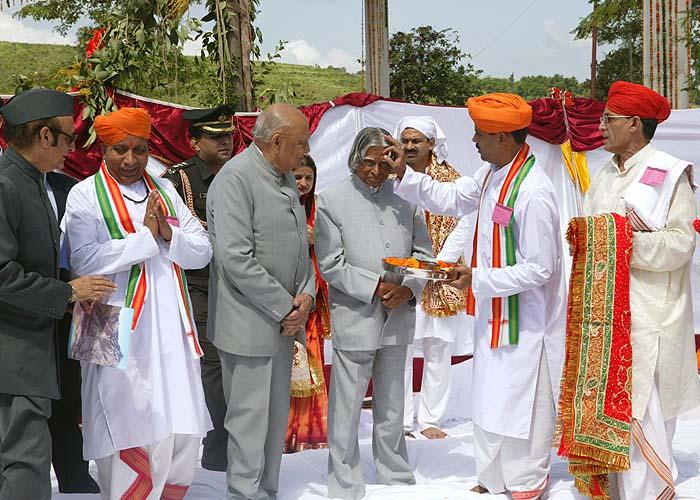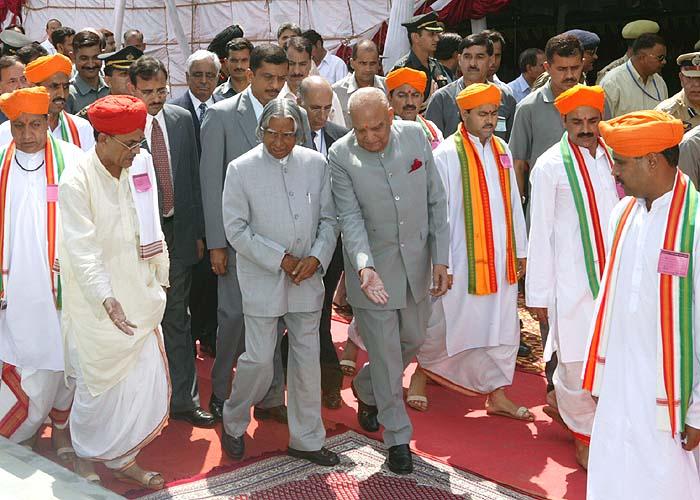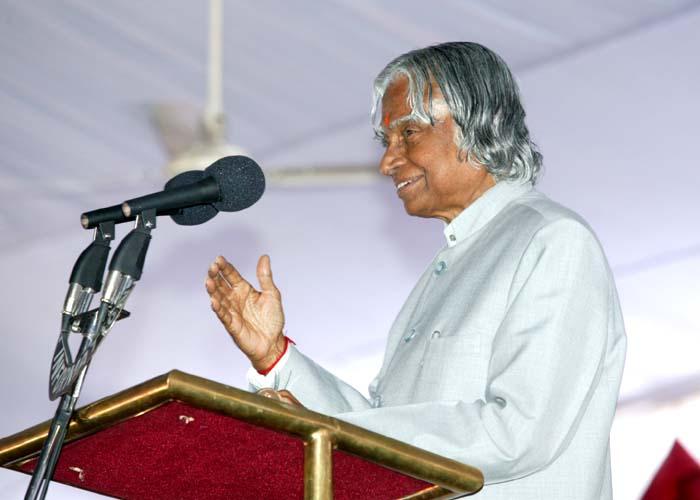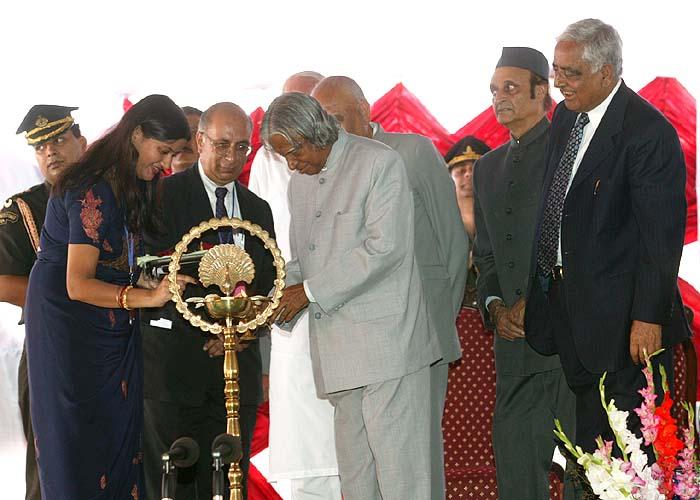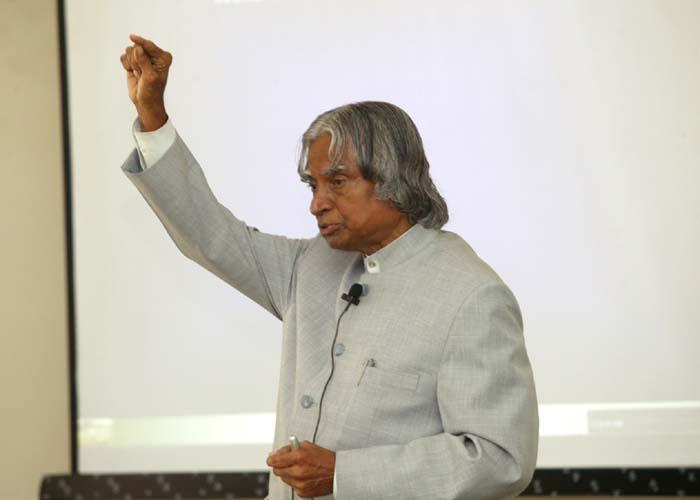Inaugural Address At The Shri Mata Vaishno Devi University
Jammu : 19-08-2004
Capacity Building for National Development
I am delighted to participate in the inauguration of the Shri Mata Vaishno Devi University, Jammu. My greetings to the Chancellor, Vice-chancellor, members of the State Government, faculty members, students and distinguished guests. The strength of a nation comes out of economic growth and the ability to defend itself. Hence progress of the nation is strongly linked to an integrated approach to economic development and national security. Particularly for teachers; I myself was a teacher, a Professor of Technology and Societal Transformation in Anna University. I would like to convey an important message from one teacher to another that good teachers can do extremely well, if they keep their mind in a state of intellectual alertness through continuous research and teaching. Guiding students in different research areas generates creativity and enhances the quality of teaching. The teaching gets quality with one?s base of research. I would like to discuss on the topic "Capacity Building for National Development."
During my visit to various States, I have met the Vice Chancellors of various Universities of Bihar, Vice Chancellors of Universities at AndraPradesh and Vice Chancellors of Jammu and Kashmir University, Srinagar, Vice-Chancellor of all India Universities at Tirupathi and Bangalore. The focus of the discussion in these meetings was on:
1. The influence of teachers on students to make them enlightened citizen
2. Contribution of Universities and colleges towards nation?s development.
To this question, I have come across a thought provoking answer from a Professor from Texas A&M University - Dr. Robert Slater, who has read this on the above news item at Hyderabad and responded through e-mail with detailed analysis. He has discussed the following aspects that are relevant for the evolution of a new university such as Shri Mata Vaishnov Devi University:-
- What kind of human beings do want to make of ourselves?
- What capacities do we want to give to our Students?
- What kind of educational system will it take our students to acquire or develop the capacities we think they must have?
- What kind of leadership is necessary to design, sustain and protect these institutions?
Dr. Slater and myself had a detailed discussion and arrived at the conclusion that the students need to have the following capacities:
- Capacity for research or inquiry
- Capacity for creativity and innovation
- Capacity to use of high technology
- Capacity for Entrepreneurial leadership,
- Capacity for Moral leadership.
The combination of the five characteristics will result in evolution of an enlightened citizen.
Research and enquiry
The 20th century was for the generation of knowledge. The 21st century will be about the management of all the knowledge and information we have generated and give value to it. We must give our students, the skills with which they find a way through the sea of knowledge that we have created and continue with life long learning. Today, we have the ability, through technology, to really and truly teach ourselves and to become the life-long learners that any sustained economic and political development requires.
Creativity and innovation: We can best teach ourselves by teaching others. The management of knowledge in 21st century is beyond the capacity of individuals. The amount of information that we have is overwhelming and has exceeded the capacity of individuals. The management of knowledge therefore must move out of the realm of the individual and into the realm of the society. The students must learn how to manage knowledge collectively. In other words they must not only learn themselves, but also teach others and learn as teams.
Capacity to use of high technology: Every student in our colleges should learn to know how to use the latest technologies for aiding their learning process. Colleges should equip themselves with adequate computing equipment, laboratory equipments, Internet facilities and provide an environment for the students to enhance their learning ability.
Entrepreneurship: The aptitude for entrepreneurship should be cultivated in the college environment itself. We must teach our students to take calculated risks for the sake of larger gain. They should also cultivate a disposition to do things right. This capacity will enable them to take up challenging tasks later. Moral leadership: Moral leadership involves two aspects. First it requires the ability to have compelling and powerful dreams or visions of human betterment. A state of things in which human beings could be better off in the future than they are now. Moral leadership requires a disposition to do the right thing and influence others also to do right things. Nobility in thinking and action will be the result of such an educational system. These five kinds of capabilities are most central for economic development and nation building. If we develop in our students these five capacities we will produce a certain kind of learner ? what he calls the ?Autonomous Learner?, a self directed, self-controlled, life-long learner who has the capacity to both respect authority while at the same time he is capable of questioning authority in an appropriate manner. And having created autonomous learners we will be well on the way to creating autonomous adults, the kind of adult that a democratic nation cherishes to have. These thoughts on education are the basis of evolution of new universities.
I suggest each one of you think more about it with the objective of creating enlightened citizens and practice to contribute towards national development.
A multi-pronged approach for Tele-Education
Recently, I was in Bangalore inaugurating the EDUSAT programme. This EDUSAT system can enrich the distant learning process by all our universities and educational institutions. Now I would like to discuss some of the features of the tele-education system which can be used by Shri Mata Vaishno Devi University.
A three-pronged approach is essential to make distance education programme viable and a successful proposition through the universal tele-education system to all remote parts of the country. The three components may be the Connectivity, Tele-Education System and the Quality Content Generation and deployment.
Connectivity: EDUSAT is expected to provide one-lakh fifty thousand ground terminals in its full capacity. The other parts of the country have to be covered by providing Broadband and Wireless communication network in an integrated fashion. Terrestrial optical communication is becoming cost effective and can complement the space communication with its low cost, high bandwidth and networking capability. An integrated networked system comprising EDUSAT, Broadband and Wireless networks should provide a highway for reaching quality education to all parts of the country. In partnership with ISRO, a connectivity to distance education can be established in all the universities of J&K.
Tele-Education System: Once we have the connectivity, then there should be a universal tele-education system in place for making full utilization of the connectivity to bring virtual classrooms in a multi class environment with seamless two-way interaction between the teachers and students in a collaborative environment. This system should not only enable the lecture delivered from the Studio at the university to reach any remote corner but also enable a good teacher in the remote area to provide multicast information to other participants of the programme. A Tele-Education delivery system: I would like to narrate our experience in tele-education piloted at Rashtrapati Bhavan for providing satellite connectivity for the PREVIK (President?s Virtual Institute for Knowledge) members. The connectivity is through V-SATs provided by ISRO, Voice Over-IP and Internet. In this platform, the live virtual studio environment is created and it will connect a number of remote locations and provides seamless, one to many connectivity, through multicasting mode in a collaborative environment. This also provides two-way connectivity. In this platform, I can give a presentation and address the remote locations, where the multimedia delivery is possible and also I can interact through various collaborative tools. I can refer any informational website from Internet to all the remote locations and can also delegate the remote expert to give a lecture to all those who are connected. We have also established the Digital Library and digitized around 2 million pages. I can search for a particular page and push the page to all the participants through this tele-education. It is an integrated solution, which makes me feel as if I am virtually connected to all participants in multiple locations. In the present context with respect to universities, EDUSAT provides the connectivity. An integrated Tele-education delivery mechanism is available and being used. I can arrange the university to have the tele-education delivery system. What is required now is the generation of quality content for sharing and transmitting to remote students. Quality Content Generation: There are three components for education: lectures, laboratory and library. The content includes all the above three. Content can be generated in many ways. The first one is the assimilation of the subject by an expert teacher through research study of many books and articles leading to the generation of quality and creative content in a presentable format. The teacher presents in a unique and innovative way to make the content appealing and easily understandable to the students. The second form of content could be on a self-learning method by breaking down the content into a series of question answer models. Third may be from various books, which can be extracted through a digital library and presented just-in time to all the remote students. Fourth may be from Internet, where wealth of information is available. Teacher may search the information in the Internet and push the content live through the tele-education system.
The content should have supportive animations, which may even bring virtual laboratories and virtual immersion effects to the remote students. When the content is generated, it should be a sharable learning object across the nation and across all platforms. Shri Mata Vaishno Devi University can generate content in the specialist area of information technology and business administration. The content may be generated making use of the student?s creative and innovative thoughts under the guidance of the expert teachers as a group activity based on a pre-determined standard. This will enable building up of capacity into the student to teach while studying. The generated content through this process may be validated and deployed for delivery of lectures through tele-education system.
As an example, my lectures delivered during various sites are dynamically updated in our website. During the address many participants ask questions on several topics. The answers to these questions are also placed in the website as supplementary information. Similarly, the teachers after delivering the talk will also be asked a number of questions by the students. The proceedings of the questions & answers session can be added to the content document for enriching it.
Through this multi-pronged process Shri Mata Vaishno Devi University can teach many students located in remote areas in the valley and areas in the complex spread over.
Collaborative Research Areas
Bio-Technology: I understand that the University is commencing a bio-technology course from the next academic year. Jammu and Kashmir being extremely rich in plant resources I would recommend creation of a herbal park and Jatropha farm in a specially ear-marked area. The University should have a collaborative project among Regional Research Laboratory, Jammu and a Pharma Industrial Partner. The Consortium partners can advise on the syllabus to be formulated, creation of infrastructural facilities and the structure of the Herbal park. The aim should be to convert the herb to a molecule and finally to a medicine by the partners. Also, the Jatropha plantation should lead to the production of bio-diesel with an industrial partner. Work on these areas can commence right now so that by the time the Department inducts the students next year the plantations would be ready for research work. These areas of research will lead to creation of small enterprises in Jammu & Kashmir which can be run by the graduates passing out from this University and provide employment for many people living in the villages.
The Bio-technology Department can work on developing Jatropha varieties having higher yield of diesel and better quality of high efficacy herbal molecules. Bio-technology tools for all these are available. The faculty for the new Department can be augmented from RRL and and industrial partner and the students from the Department can be deputed to work in RRL and the industry on specific bio-technology project.
Indian Philosophy and Culture: I note that this year in addition to B.Tech Information Technology and Masters? in Business Administration Shri Mata Vaishno Devi University is commencing a school of Indian Philosophy and Culture. This is a unique subject and I would recommend that the students in this area could be given a research project to study the spiritual component of all the religions and bring out the unity in diversity of religions. This study should enable the integration of multiple religions leading to a harmonious society. The teaching and research in philosophy should result in spreading nobility in the way of life.
Conclusion
Paradigm of computer has started moving towards any place, any time because of the exponential increase in the speed of the computer and network; it is immaterial where you are. If you democratize it, that is called democratization of knowledge, it is anyone, any time, any place. EDUSAT may be extremely helpful in making this shift possible and decreasing the digital divide.
Shri Mata Vaishno Devi University in collaboration with EduSat mission should become an instrument for cultural enlightenment for Jammu and Kashmir covering ancient, medieval and modern periods depicting cultural diversity and pluralism on the one hand and basic human unity and non-duality on the other. The ancient dictum of universal family and the conditionality to promote a dialogue within the state and across the States throughout the country, around the concept of the Nation as a one single human family, as it is relevant to achieve peace and prosperity in modern times, is yet another example under the Cultural Areas of Learning with connectivity to knowledge centres.
I inaugurate the Shri Mata Vaishno Devi University and wish all members of this University success in their mission of promoting creative education through technology, connecting the rural population.
May God bless you.
Documents

